Devlog 1: The research 🔎
Introduction
Hey there!
We’re excited to share the journey of our game with you developed as part of the Game Projects course at Digital Arts and Entertainment.
We're a group of artists and programmers coming together to combine our skills and create a fun game! On the programming side we have David, Jakub, Tuur and on the artistic side Patricija, Akshit and Len. Over the next weeks we'll be bringing a funny stealth-based game to life inspired by a classic slapstick comedy called Kidults. We hope you'll join us on this journey!
Kidults is a balancing co-op game about two kids who're trying to sneak into a cinema disguised as an adult based on the classic "two kids in a trench coat" trope. The fun part of the game is struggling to walk and act "normal" without raising suspicions while being stacked up on each other, covered only by a coat.
Coding
Unreal vs Unity
During our first meeting we immediately agreed on using Unreal engine for our project. This was by all means not an educated guess based on what we will need as we did not even know what we will be making back then. What we did know is that we all prefer Unreal and believe that we should be able to work faster as we are familiar with the engine; all of our artists had multiple courses which utilised Unreal while the programmers love C++. We do believe that Unity has it's use cases and it could very much be that it would have been better suited for this project, however most of us will be working with either Unreal or a propriatery engine after finishing our studies as these are the most common options in the triple A industry. Based on these choices, we have decided to go with Unreal.
Balancing mechanic
Now that you know what game idea we have in mind and which engine we have settled on, it's time to get into the technical aspects of Kidults. First and foremost; how will we approach the balancing mechanic?
We have two (pretty obvious) candidates at the moment - a physics solution and a kinematic solution.
The programmers worked on prototypes for both of them. In theory both approaches give us similar results but they will impact the movement pretty heavily at the end.
The first approach is using Unreal's physics constraint. As show in the image below, there will be two boxes dictating the players collision, a point that holds both models in place called the physics constraint and the maximum angle at which the physics constraint can move. That way we achieve more "wobbly" controls comparable to something like Gang Beasts.
The second approach works basically the same but without a physics constraint. We apply the forces ourselves which gives us more control over the players.
We have yet to decide which approach is better for our purposes. For now, we will continue working on the prototypes and do some playtesting to determine the better solution.
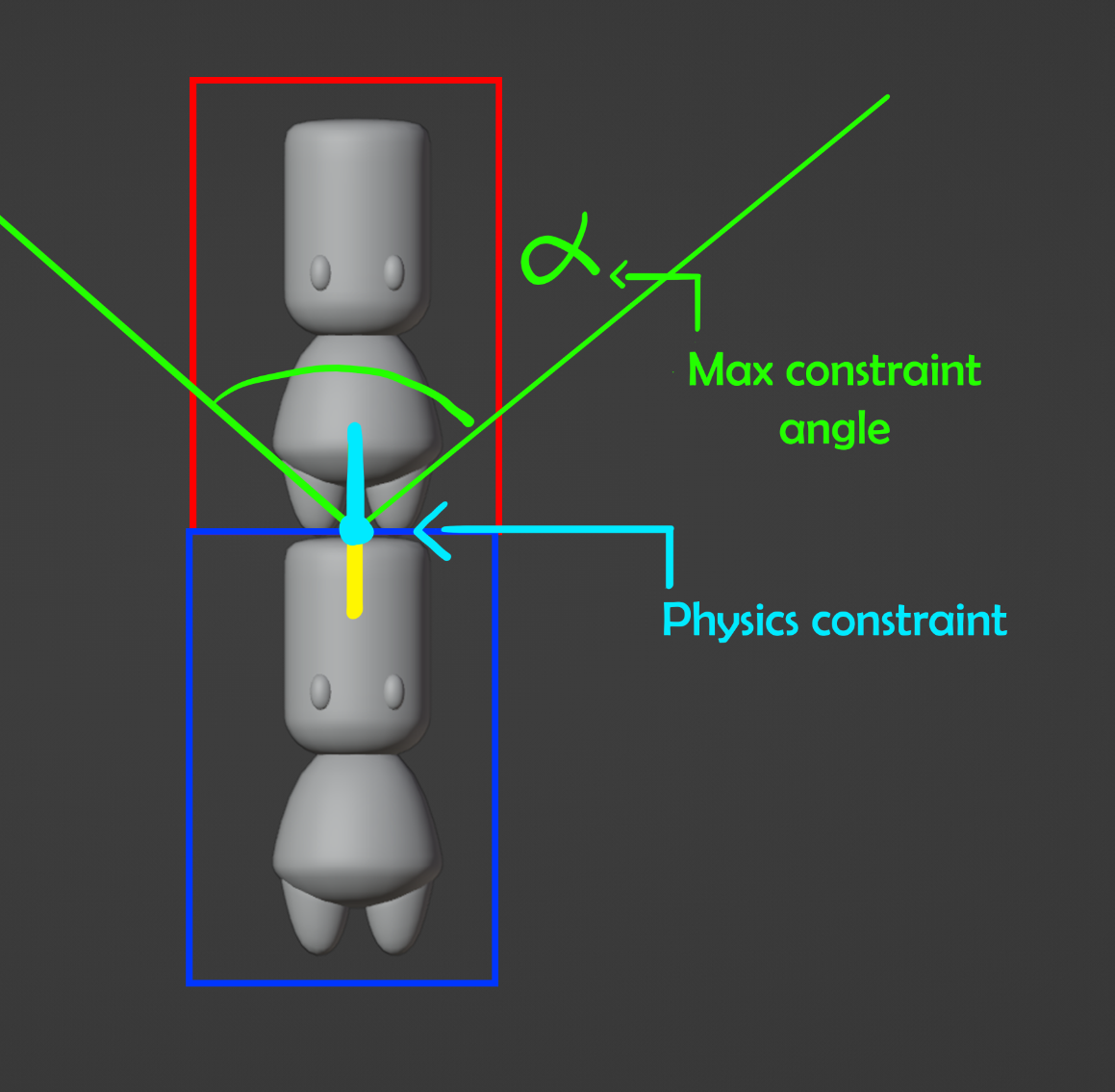
Forward vs Deferred rendering
We have extensively tested both rendering methods and concluded that deferred rendering is our choice. While testing we focused on several aspects, like graphical fidelity, performance etc.
We've used a scene provided by one of our artists. On the left we've used forward rendering and on the right deferred rendering.
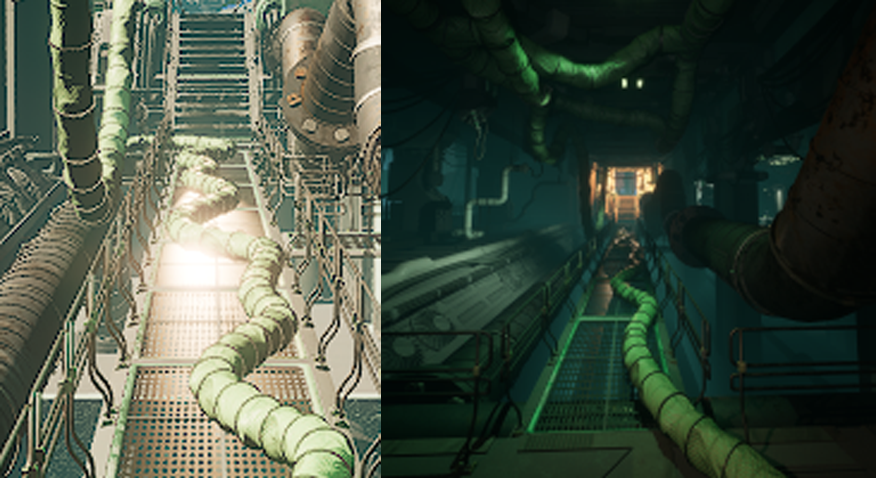
In terms of visual fidelity, deferred rendering takes the lead thanks to the support for multiple dynamic light sources next to each other which together create the ambience of the scene.
Besides the lower graphical fidelity, forward rendering inverts normal maps. It's not that big of an issue but it's worth mentioning since there will be extra work if we decide to bake normal maps.
Since forward rendering is made with mobile/VR in mind it supports significantly less shader instructions. One of the most common ones are the translucent materials and scene texture nodes. You also lose the ability to write from the buffer passes since the final image is generated in the forward shading.
This all sounds great, but of course there is a trade-off; the scene rendered using forward rendering performed 40% faster.
While having 40% more performance with forward rendering is very nice we will be limiting our tech artist to use primitive methods for rendering. Since the art style of the game is simple we can allow ourselves to use a better and advanced rendering system
Art
Style
Our game is designed to be a fun experience for casual gamers. Combined with the gameplay and the setting of our game, we decided to aim for a cute, stylized art style. The shapes will be very simplified, mainly rounded, the colors vibrant and the proportions seriously exaggerated. This will enhance our creative freedom and help us ensure the game stands out with a recognizable identity. The stylized design and exaggerated shape language will keep our game visually appealing, ensuring its longevity for players over time.
We also want to guide the player with the shape language of the characters. This will help players instantly recognize who to trust and who to avoid.
For our textures we wanted to test out shaders that have a "hand painted" effect to achieve a warm, artistic look that enhances the game's stylized aesthetic. Since our shapes are simple and stylized, we want our textures to complement instead of overwhelm.
One of the challenges of the game is making two separate characters appear as one convincing adult, seamlessly blending them into both the crowd of NPCs as well as the game’s environment. For this reason we created quick sketches to see if this would work, as our main focus of the game is the characters.
When it comes to the camera, we want to keep it simple and have a fixed camera looking 'inside' of the cinema. One of our artists, Akshit, created a quick sketch of the level.
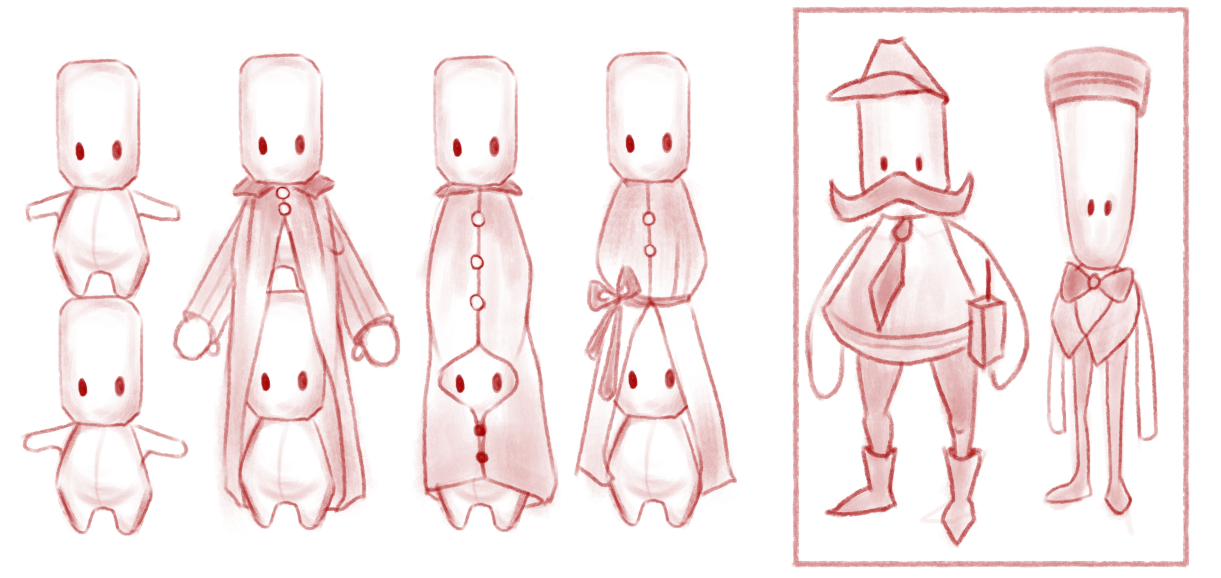
Shaders
We want every moment of our game to be as clear, playful, and hilarious as possible. To make sure nothing gets in the way of the action, we’ve created two key shaders that keep visibility smooth and enhance our stylized look.
Dynamic fade shader
Since we’re using an orthographic camera, objects that get too close can easily block the player’s view. This shaders solves this by making walls and large objects disappear at just the right moment. Objects fade based on their distance from the camera, so when you rotate the view, walls will seamlessly disappear to keep the action visible. The transition is smooth and natural, blending objects in and out without feeling jarring. This keeps the focus on the players while making the world feel solid and immersive.
Cartoon Shader
We want our game to feel soft, warm, and playful, while still making the characters stand out. This shader helps bring out the game’s fun and exaggerated style. The Fresnel effect creates a soft, stylized lighting transition, keeping shading simple yet expressive. A crisp outline around objects makes everything easy to read at a glance, reinforcing the game’s playful aesthetic. The shader is highly customizable, allowing us to fine-tune the balance between textures and models without overwhelming the design.
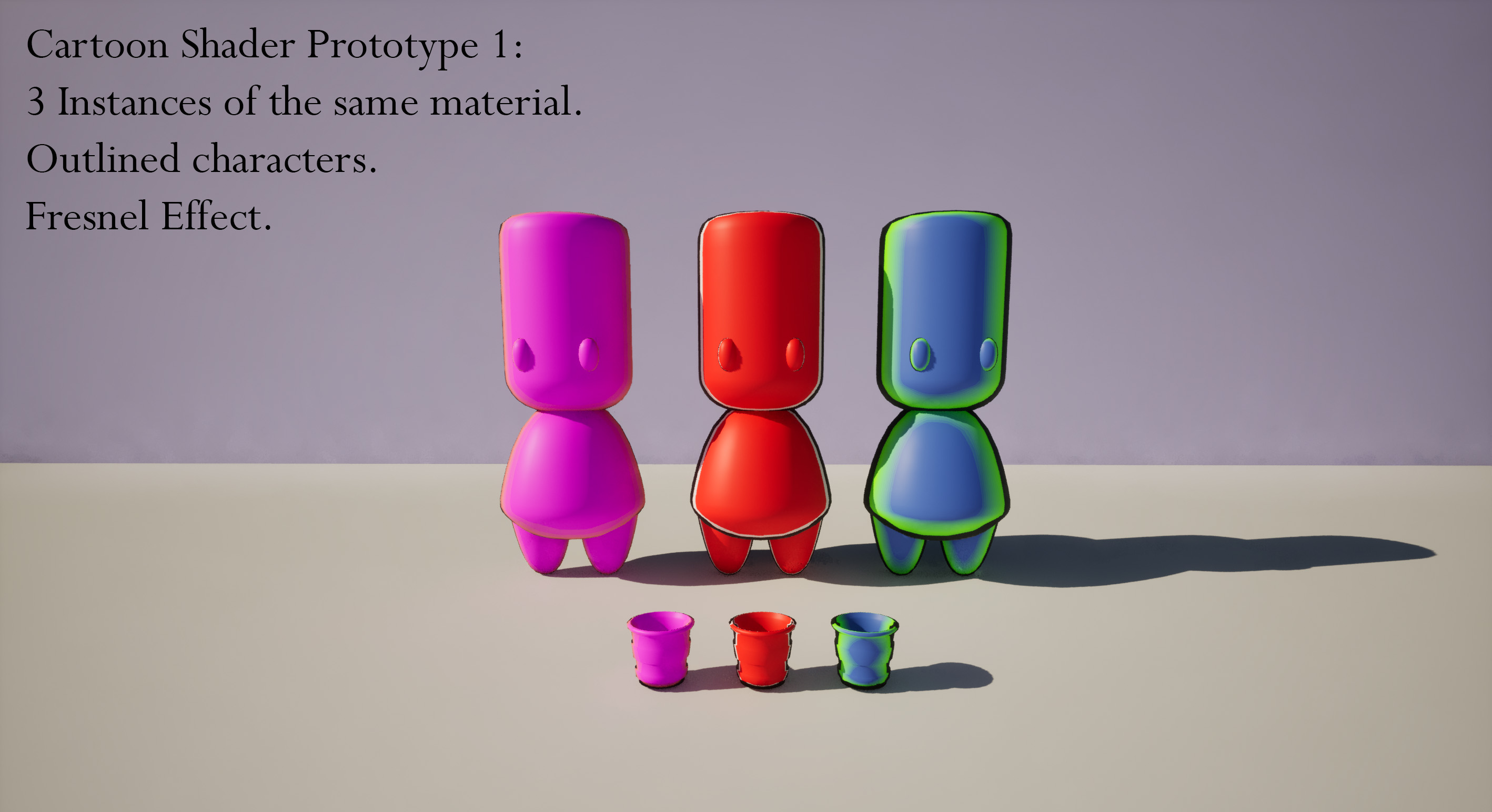
These shaders work together to keep the game’s visuals clear, readable, and full of personality, making sure players can always focus on the fun and chaos!
Whats next?
- For our prototypes David, Jakub and Tuur will develop playable prototypes with the focus on movement. Since this is our main game mechanic, we want to make sure it is as refined as possible.
- Our artists Patricija, Len and Akshit will continue working on the Art Bible and focus on how everything comes together. Len will continue on shader development to enhance the games visual quality. The goal is to put everything together and make a test environment with the characters, shaders and textures to see if everything works together.
Hope to see you next week! :)
Files
Get Kidults
Kidults
A couch, co-op game where two kids try sneaking into the cinema!
| Status | Released |
| Authors | Jakub Frątczak, Akshay02, JohnyTheCarrot, Capmare, PatricijaKeica, lenfault |
| Tags | 3D, cinema, Co-op, couch, Cute, kids, pretending, slapstick, trench-coat, Unreal Engine |
| Languages | English |
More posts
- Devlog 11: End of polishing...🔚May 25, 2025
- Devlog 10: Start of Polish 🛁May 19, 2025
- Devlog 9: End of Production🫷May 12, 2025
- Devlog 8: Getting closerMay 06, 2025
- Devlog 7: Start of the sprint 2🏃➡️🏃➡️Apr 28, 2025
- Devlog 6: End of first sprintApr 21, 2025
- Devlog 5: First Sprint 🏃Mar 24, 2025
- Devlog 4: Production Start 🏭Mar 18, 2025
- Devlog 3: Gameplay 🎮Mar 10, 2025
- Devlog 2: Prototyping 🛠️Mar 02, 2025

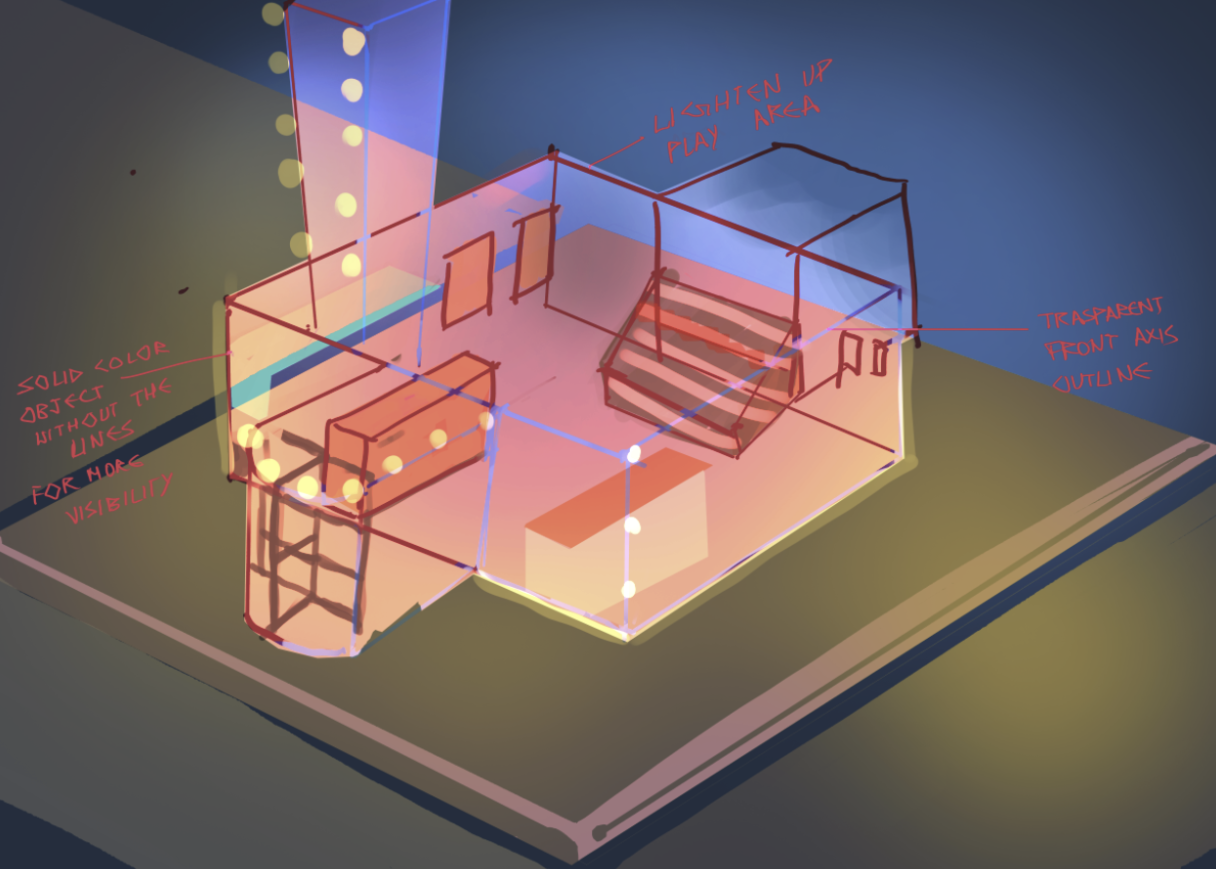

Comments
Log in with itch.io to leave a comment.
WOW Im super curious to see where this project will go.
Keep us posted!
Will do! Glad to see you here with us!